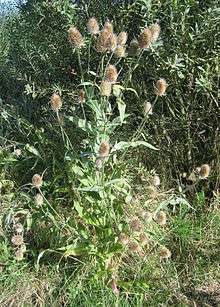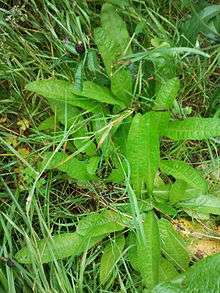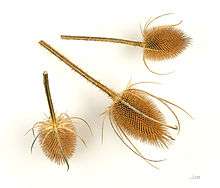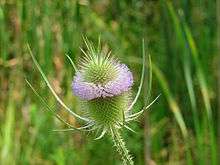Dipsacus fullonum
| Wild teasel | |
|---|---|
 | |
| Scientific classification | |
| Kingdom: | Plantae |
| Clade: | Angiosperms |
| Clade: | Eudicots |
| Clade: | Asterids |
| Order: | Dipsacales |
| Family: | Caprifoliaceae |
| Genus: | Dipsacus |
| Species: | D. fullonum |
| Binomial name | |
| Dipsacus fullonum | |
| Synonyms[1] | |
|
List
| |
Dipsacus fullonum, syn. Dipsacus sylvestris, is a species of flowering plant known by the common names wild teasel or fuller's teasel, although the latter name is usually applied to the cultivated species Dipsacus sativus.[2] It is native to Eurasia and North Africa, but it is known in the Americas, southern Africa, Australia and New Zealand as an introduced species and often a noxious weed. It forms large monocultures (displacing other species) in areas it invades that have favorable climates and none of its biological control species. The inflorescence is a cylindrical array of lavender flowers which dries to a cone of spine-tipped hard bracts. It may be 10 centimeters long.
.jpg)
It is a herbaceous biennial plant (rarely a short-lived perennial plant) growing to 1–2.5 metres (3.3–8.2 ft) tall.
Two moths useful for biological control were tested in Slovakia in 2003-2004 (following the identification of seven insects associated with the plant and their consideration), including the monophagous Endothenia gentianaeana. Although Endothenia gentianaeana was able to be reared in high numbers and its presence was found in nearly 100% of teasel plants surveyed in Slovakia, and despite the high level of damage caused by the second moth, Cochylis roseana (which was not targeted by local parasitic wasps frequently as was Endothenia gentianaeana), the USDA has not approved either of these moths for introduction as of February 2018. Instead, the USDA continues to suggest the use of herbicidal chemicals.[3]
Description

The genus name is derived from the word for thirst and refers to the cup-like formation made where sessile leaves merge at the stem. Rain water can collect in this receptacle; this may perform the function of preventing sap-sucking insects such as aphids from climbing the stem. A recent experiment has shown that adding dead insects to these cups increases the seedset of teasels (but not their height), implying partial carnivory.[4] The leaf shape is lanceolate, 20–40 centimetres (7.9–15.7 in) long and 3–6 centimetres (1.2–2.4 in) broad, with a row of small spines on the underside of the midrib.
Teasels are easily identified with their prickly stem and leaves, and the inflorescence of purple, dark pink or lavender flowers that form a head on the end of the stem(s). The inflorescence is ovoid, 4–10 centimetres (1.6–3.9 in) long and 3–5 centimetres (1.2–2.0 in) broad, with a basal whorl of spiny bracts. The first flowers begin opening in a belt around the middle of the spherical or oval flowerhead, and then open sequentially toward the top and bottom, forming two narrow belts as the flowering progresses. The dried head persists afterwards, with the small (4–6 millimetres (0.16–0.24 in)) seeds maturing in mid autumn.
Wildlife interaction
The seeds are an important winter food resource for some birds, notably the European goldfinch. Teasels are often grown in gardens and encouraged on some nature reserves to attract them.[5]
Cultivation and uses
The Fuller's Teasel (the cultivar group Dipsacus fullonum Sativus Group; syn. D. sativus) was formerly widely used in textile processing, providing a natural comb for cleaning, aligning and raising the nap on fabrics, particularly wool.[6] It differs from the wild type in having stouter, somewhat recurved spines on the seed heads. The dried flower heads were attached to spindles, wheels, or cylinders, sometimes called teasel frames, to raise the nap on fabrics (that is, to tease the fibres).[7] By the 20th century, teasels were largely replaced by metal cards, which could be made uniform and do not require constant replacement as the teasel heads wear. However, some people who weave wool still prefer to use teasels for raising the nap, claiming that the result is better; in particular, if a teasel meets serious resistance in the fabric, it will break, whereas a metal tool would rip the cloth.
Teasels are also occasionally grown as ornamental plants, and the dried heads are used in floristry.
Teasels have been naturalised in many regions away from their native range, partly due to the import of Fuller's Teasel for textile processing, and partly by the seed being a contaminant mixed with crop seeds.
Gallery
- Teasel comb
 Dried teasel flower head, used to raise the nap on cloth
Dried teasel flower head, used to raise the nap on cloth Teasel leaves after flower stem development, high on stem
Teasel leaves after flower stem development, high on stem Teasel seedling
Teasel seedling
References
- ↑ "The Plant List: A Working List of All Plant Species". Retrieved April 19, 2014.
- ↑ "BSBI List 2007". Botanical Society of Britain and Ireland. Archived from the original (xls) on 2015-01-25. Retrieved 2014-10-17.
- ↑ Sforza, R.; Bon, M.C. (2008). Proceedings of the XII International Symposium on Biological Control of Weeds. CAB International. p. 216-218. ISBN 978-1-84593-506-1.
- ↑ Shaw, P. J. A.; Shackleton, K. (2011). Joly, Simon, ed. "Carnivory in the teasel Dipsacus fullonum — the effect of experimental feeding on growth and seed set". PLoS ONE. 6 (3): e17935. doi:10.1371/journal.pone.0017935. PMC 3060873. PMID 21445274.
- ↑ "Advice from the Royal Society for the Protection of Birds on how to attract Goldfinch to your garden with teasel". Retrieved October 16, 2011.
- ↑ "Teasel." The Oxford English Dictionary. 2nd ed. 1989.
- ↑ "Teasel Handles and Teasel Gigs in the Trowbridge Museum". Archived from the original on September 27, 2011. Retrieved October 16, 2011.
External links
| Wikimedia Commons has media related to Dipsacus fullonum. |
- Species Profile- Common Teasel (Dipsacus fullonum L.), National Invasive Species Information Center, United States National Agricultural Library. Lists general information and resources for common teasel.
- Jepson Manual Treatment
- Virginia Tech Weed Guide
- Photo gallery
